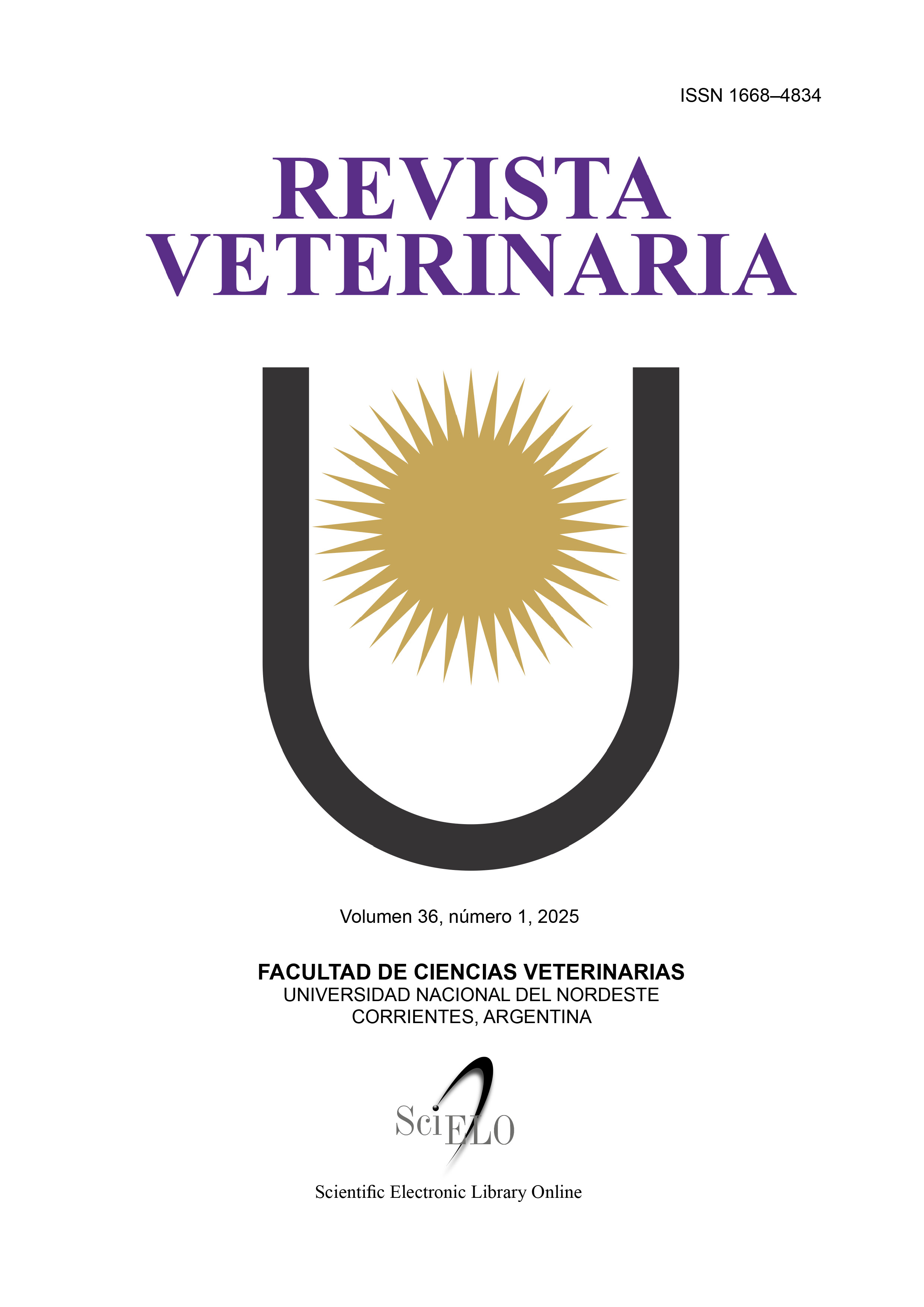Efecto del tipo de galpón sobre indicadores de bienestar animal en pollos híbridos para carne
DOI:
https://doi.org/10.30972/vet.3617989Palabras clave:
avicultura, alojamiento, ambiente, veranoResumen
La industria del pollo para carne constituye una de las principales fuentes de proteína animal y requiere de instalaciones y equipamiento de alto nivel tecnológico. El objetivo del presente ensayo fue evaluar el bienestar animal de pollos para carne en dos tipos de galpones, mediante el empleo de cuatro indicadores basados sobre los animales con una metodología individual. El ensayo fue realizado en el noreste de la provincia de Santa Fe (Argentina) en dos ciclos productivos de verano. Fueron testeados ocho galpones cerrados de ventilación forzada, cuatro de tipo blackout (Oscuros) y cuatro de tipo túnel (Claros), pertenecientes a cuatro granjas de engorde. Entre los días 35 y 42 del ciclo fueron capturados 25 pollos machos y hembras del híbrido Cobb 500(R) en cada uno de cinco puntos del galpón, en los que se observó: suciedad de plumas (SP), lesiones de almohadilla plantar (LAP), quemadura de tarso (QT) y marcha (M), con la escala de gravedad establecida por la metodología de Welfare Quality®. Fueron observadas diferencias estadísticamente significativas entre los tipos de galpones en las cuatro variables mediante una prueba chi-cuadrado de homogeneidad. En SP (p = 0,0103) y LAP (p<0,0001) estas diferencias mostraron mayor proporción de suciedad de plumas y afección de las almohadillas plantares en los galpones Claros. En en el caso de QT (p = 0,0002) y M (p<0,0001) fue observado un mayor porcentaje de pollos afectados en los galpones Oscuros. Los resultados muestran que las instalaciones utilizadas con el fin de proporcionar condiciones de crianza adecuadas, aún requieren de ajustes precisos de las interacciones entre los componentes del medio ambiente en el que se desenvuelven para mejorar el bienestar animal.
Descargas
Citas
Abeyesinghe SM, Chancellor NM, Moore DH, Chang YM, Pearce J, Demmers T, Nicol, CJ. Associations between behavior and health outcomes in conventional and slow-growing breeds of broiler chicken. Animal. 2021; 15(7): 100261.
Alvino GM, Archer GS, Mench JA. Behavioral time budgets of broiler chickens reared in varying light intensities. Appl Anim Behav Sci. 2009; 118(1-2): 54-61.
Amer MM. Footpad dermatitis (FPD) in chickens. The Korean Journal of Food & Health Convergence. 2020; 6(4): 11-16.
Broom DM. Indicators of poor welfare. Br Vet J. 1986; 142: 524-526.
Broom DM. Animal welfare: concepts, study methods and indicators. Rev Colomb Cienc Pec. 2011; 24(3): 306-321.
Butterworth A. Welfare assessment of poultry on farm. In Advances in poultry welfare. 2018; 113-130.
Camacho Chacón J, Castro Murillo M, Reyes Moreno LL. La ciencia del bienestar animal: conceptualización y discusión. Revista De Filosofía De La Universidad De Costa Rica. 2019; 58(150-151): 89-98.
Daghir NJ. Poultry production in hot climates. 2008. Cabi. (Ed.). ISBN: 978-1-84593-417-0, 375 p.
Davis NJ, Prescott NB, Savory CJ, Wathes CM. Preferences of growing fowls for different light intensities in relation to age, strain and behavior. Anim. Welf. 1999; 8(3): 193-203.
de Jong IC, Hindle VA, Butterworth A, Engel B, Ferrari P, Gunnink H, Pérez Moya T, Familia Tuyttens, van Reenen CG. Simplifying the Welfare Quality® assessment protocol for broiler chicken welfare. Animal. 2016; 10(1): 117-127.
Donald J. Manejo del ambiente en el galpón de pollo de engorde. Aviagen Incorporated; 2009. Recuperado de https://es.aviagen.com/assets/Tech_Center/BB_Foreign_Language_Docs/Spanish_TechDocs/Aviagen-Manejo-Ambiente-Galpn-Pollo-Engorde-2009.pdf
EFSA AHAW Panel (EFSA Panel on Animal Health and Welfare), Nielsen, SS, Alvarez, J, Bicout, DJ, Calistri, P, Canali, E, Michel, V. Welfare of broilers on farm. EFSA Journal. 2023; 21(2): e07788.
Freeman N, Tuyttens FA, Johnson A, Marshall V, Garmyn A, Jacobs L. Remedying contact dermatitis in broiler chickens with novel flooring treatments. Animals. 2020; 10(10): 1761.
García RG, Lima NDD S, Naas IDA, Caldara FR, Sgavioli S. The typology of broiler house and the impact in the locomotion of broilers. Engen. Agríc. 2018; 38: 326-333.
Granquist EG, Vasdal G, De Jong IC, Moe RO. Lameness and its relationship with health and production measures in broiler chickens. Animals, 2019; 13(10): 2365-2372.
Gomes De Oliveira R, José Camargos Lara L. Lighting programmes and its implications for broiler chickens. Worlds Poult Sci J. 2016; 72(4): 735-742.
Hofmann T, Schmucker SS, Bessei W, Grashorn M, Stefanski V. Impact of housing environment on the immune system in chickens: A review. Animals. 2020; 10(7): 1138.
INET. MINAGRI. Sector avícola. Informe final preliminar. 2010. Disponible en: http://catalogo.inet.edu.ar/files/pdfs/info_sectorial/avicola-informe-sectorial.pdf
Kang SW, Christensen KD, Kidd Jr MT, Orlowski SK, Clark J. Effects of a variable light intensity lighting program on the welfare and performance of commercial broiler chickens. Front. Physiol. 2023; 14: 1059055.
Kim HJ, Son J, Jeon JJ, Kim HS, Yun YS, Kang HK, Kim JH. Effects of photoperiod on the performance, blood profile, welfare parameters, and carcass characteristics in broiler chickens. Animals. 2022; 12(17): 2290.
Kwon BY, Park J, Kim DH, Lee KW. Assessment of Welfare Problems in Broilers: Focus on Musculoskeletal Problems Associated with Their Rapid Growth. Animals, 2024; 14(7): 1116.
Kwon BY, Lee HG, Jeon YS, Song JY, Kim SH, Ki, DW, Lee KW. Research Note: Welfare and stress responses of broiler chickens raised in conventional and animal welfare-certified broiler farms. Poult Sci, 2024; 103(3): 103402.
Liu KL, He YF, Xu BW, Lin LX, Chen P, Iqbal MK, Huang SC. Leg disorders in broiler chickens: a review of current knowledge. Anim. biotechnol. 2023; 34(9): 5124-5138.
Louton H, Bergmann S, Reese S, Erhard M, Bachmeier J, Rösler B, Rauch E. Animal-and management-based welfare indicators for a conventional broiler strain in 2 barn types (Louisiana barn and closed barn). Poult Sci, 2018; 97(8): 2754-2767.
MacDonald JM. Technology, organization, and financial performance in US broiler production. Bulletin Number 126; 2014. United States Department of Agriculture. Economic Information. Disponible en: https://www.ers.usda.gov/webdocs/publications/43869/48159_eib126.pdf?v=8437
Manser CE. Effects of lighting on the welfare of domestic poultry: a review. Anim. Welf. 1996; 5(4): 341-360.
Marchewka J, Watanabe TTN, Ferrante V, Estevez I. Welfare assessment in broiler farms: Transect walks versus individual scoring. Poult Sci. 2013; 92(10): 2588-2599.
Meluzzi A, Fabbri C, Folegatti E, Sirri F. Effect of less intensive rearing conditions on litter characteristics, growth performance, carcass injuries and meat quality of broilers. Br. Poult. Sci. 2008; 49(5): 509-515.
Ministerio de economía, Dirección de Porcinos, Aves y Animales de Granja, equipo Técnico área avícola. Pollos Parrilleros. Relevamiento Integral de Granjas. Informe 2019. https://www.magyp.gob.ar/sitio/areas/aves/encuesta/_archivos//230615_Informe%20Relevamiento%20Integral%20Granjas%20Pollos%20Parrilleros.pdf
Munir MT, Belloncle C, Irle M, Federighi M. Wood-based litter in poultry production: a review. Worlds Poult Sci J. 2019; 75(1): 5-16.
Prescott NB, Wathes CM. Reflective properties of domestic fowl (Gallus g. domesticus), the fabric of their housing and the characteristics of the light environment in environmentally controlled poultry houses. Br. Poult. Sci. 1999; 40(2): 185-193.
Rault JL, Clark K, Groves PJ, Cronin GM. Light intensity of 5 or 20 lux on broiler behavior, welfare and productivity. Poult Sci. 2017; 96(4): 779-787.
Rovers A, Christoph‐Schulz I, Brümmer N. Citizens’ perception of different aspects regarding German livestock production. Int. J. Food Syst. Dyn. 2019; 10(4): 361-374.
Sans ECO, Vale MM, Vieira FMC, Vismara ES, Molento CFM. In-barn heterogeneity of broiler chicken welfare in two industrial house designs and two seasons in Southern Brazilian subtropical climate. Livest. Scie. 2021; 250: 104569.
Saraiva S, Saraiva C, Stilwell G. Feather conditions and clinical scores as indicators of broilers welfare at the slaughterhouse. Res Vet Sci. 2016; 107: 75-79.
Szőllősi L, Béres E, Szűcs I. Effects of modern technology on broiler chicken performance and economic indicators–a Hungarian case study. Ital. J. Anim. Sci., 2021; 20(1): 188-194.
Tallentire CW, Leinonen I, Kyriazakis I. Breeding for efficiency in the broiler chicken: A review. Agron Sustain Dev. 2016; 36: 1-16.
Tavárez MA, Solis de los Santos F. Impact of genetics and breeding on broiler production performance: a look into the past, present, and future of the industry. Animal Front., 2016; 6(4): 37-41.
Tullo E, Fontana I, Peña Fernandez A, Vranken E, Norton T, Berckmans D, Guarino M. Association between environmental predisposing risk factors and leg disorders in broiler chickens. J. Anim. Sci. 2017; 95(4): 1512-1520.
Welfare Quality Assessment Protocols for Poultry (Broilers, Laying Hens). 2009. Welfare Quality Consortium, Lelystad, The Netherlands.
Wilcox CH, Sandilands V, Mayasari N, Asmara IY, Anang A. A literature review of broiler chicken welfare, husbandry, and assessment. Worlds Poult Sci J. 2024; 80(1): 3-32.
Descargas
Publicado
Cómo citar
Número
Sección
Licencia

Esta obra está bajo una licencia internacional Creative Commons Atribución-NoComercial 4.0.
Política de acceso abierto
Esta revista proporciona un acceso abierto inmediato a su contenido, basado en el principio de que ofrecer al público un acceso libre a las investigaciones ayuda a un mayor intercambio global de conocimiento. La publicación por parte de terceros será autorizada por Revista Veterinaria toda vez que se la reconozca debidamente y en forma explícita como lugar de publicación del original.
Esta obra está bajo una licencia de Creative Commons Reconocimiento-NoComercial 4.0 Internacional (CC BY-NC 4.0)










.jpg)
.jpg)



